Last Updated on March 3, 2023 by Admin
For a hospital to operate efficiently and effectively, the three important influences in its governance, medical staff, board of trustees, and administration, must work together in reasonable harmony.

Assignment Description:
Professional Development Assignment
Based on what you have learned so far this week, create a PowerPoint presentation with detailed notes for each slide that addresses each of the following points/questions. Be sure to completely answer all the questions. Use clear headings that allow your professor to know which bullet you are addressing on the slides in your presentation.
Support your content with at least four (4) citations throughout your presentation. Make sure to reference the citations using the APA writing style for the presentation. Include a slide for your references at the end.
- Title Slide (1 slide)
- For a hospital to operate efficiently and effectively, the three important influences in its governance, medical staff, board of trustees, and administration, must work together in reasonable harmony. What factors contribute to the tension that usually exists among them? (4 slides).
- Organizations such as the LeapFrog Group represent a growing trend to survey and report on the quality of hospital care and to make the findings available to the public. What are your opinions about the public’s readiness to deal with having this information available and using it to make choices about medical care? (2-3 slides)
- Hospitals are facing unprecedented financial challenges from entrepreneurial physician initiatives that are establishing competitive, free-standing diagnostic and treatment centers and specialty hospitals. What are the advantages and disadvantages to these developments from a patient perspective? (2-3 slides)
- References (1 slide)
Expert Answer and Explanation
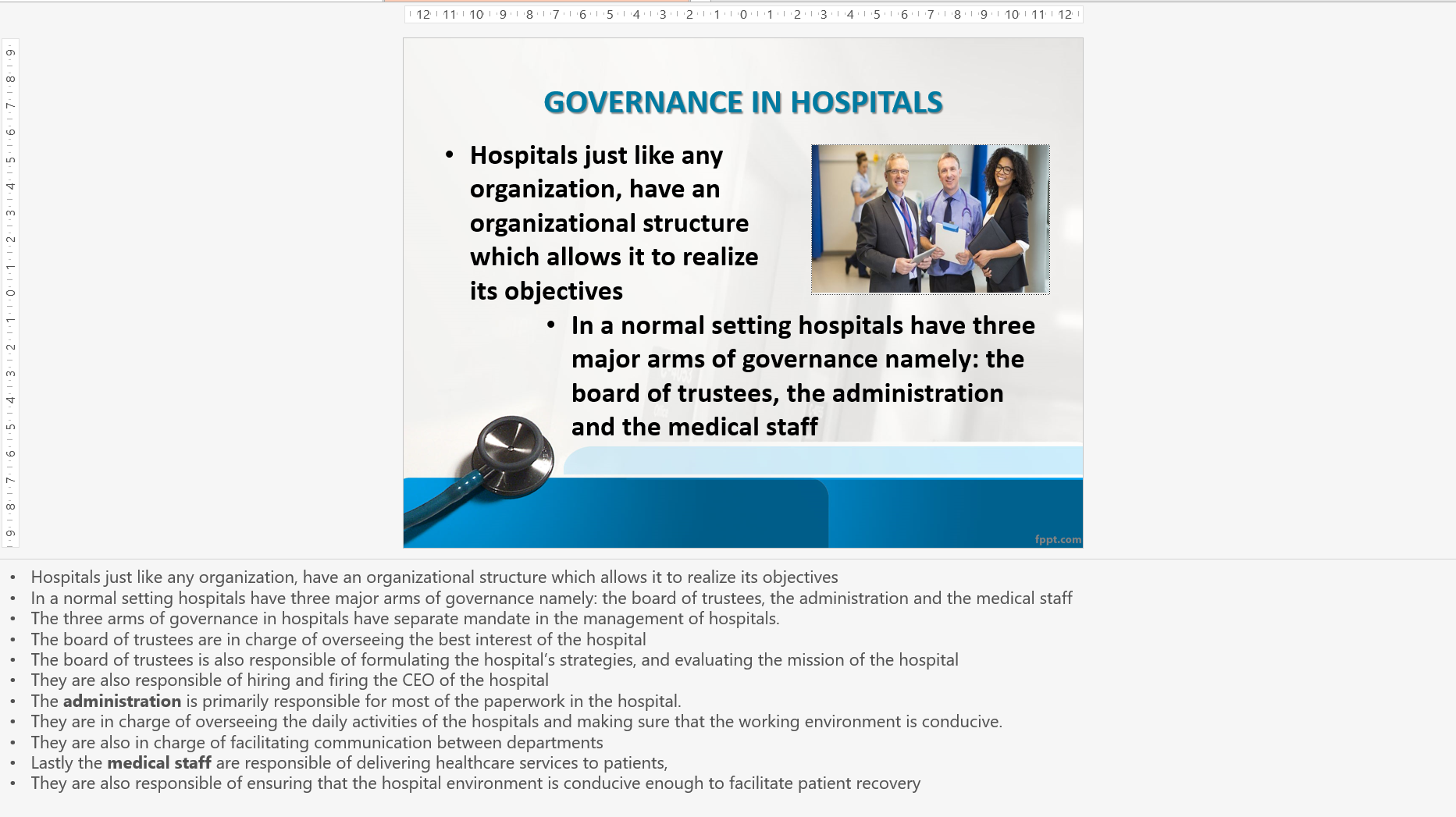
- Hospitals just like any organization, have an organizational structure which allows it to realize its objectives
- In a normal setting hospitals have three major arms of governance namely: the board of trustees, the administration and the medical staff
- The three arms of governance in hospitals have separate mandate in the management of hospitals.
- The board of trustees are in charge of overseeing the best interest of the hospital
- The board of trustees is also responsible of formulating the hospital’s strategies, and evaluating the mission of the hospital
- They are also responsible of hiring and firing the CEO of the hospital
- The administration is primarily responsible for most of the paperwork in the hospital.
- They are in charge of overseeing the daily activities of the hospitals and making sure that the working environment is conducive.
- They are also in charge of facilitating communication between departments
- Lastly the medical staff are responsible of delivering healthcare services to patients,
- They are also responsible of ensuring that the hospital environment is conducive enough to facilitate patient recovery
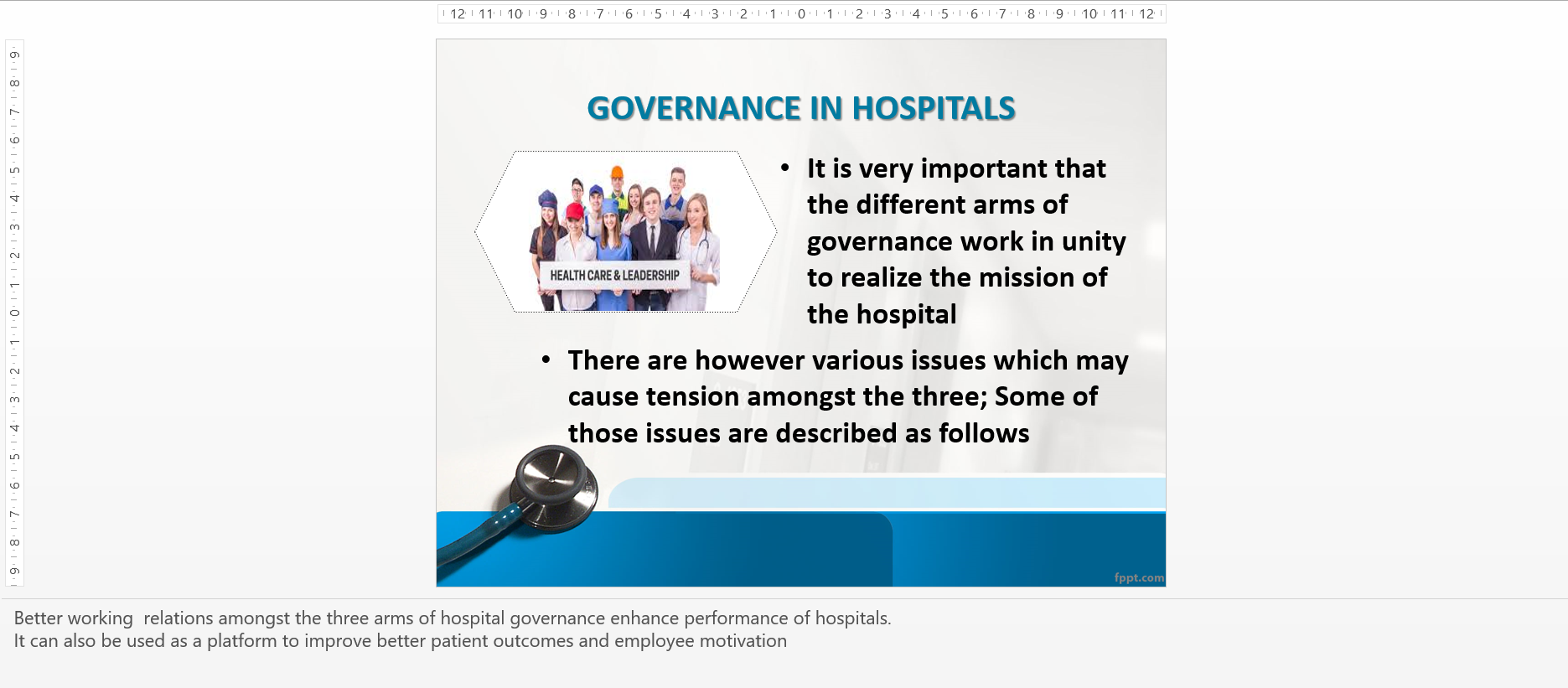
Better working relations amongst the three arms of hospital governance enhance performance of hospitals.
It can also be used as a platform to improve better patient outcomes and employee motivation
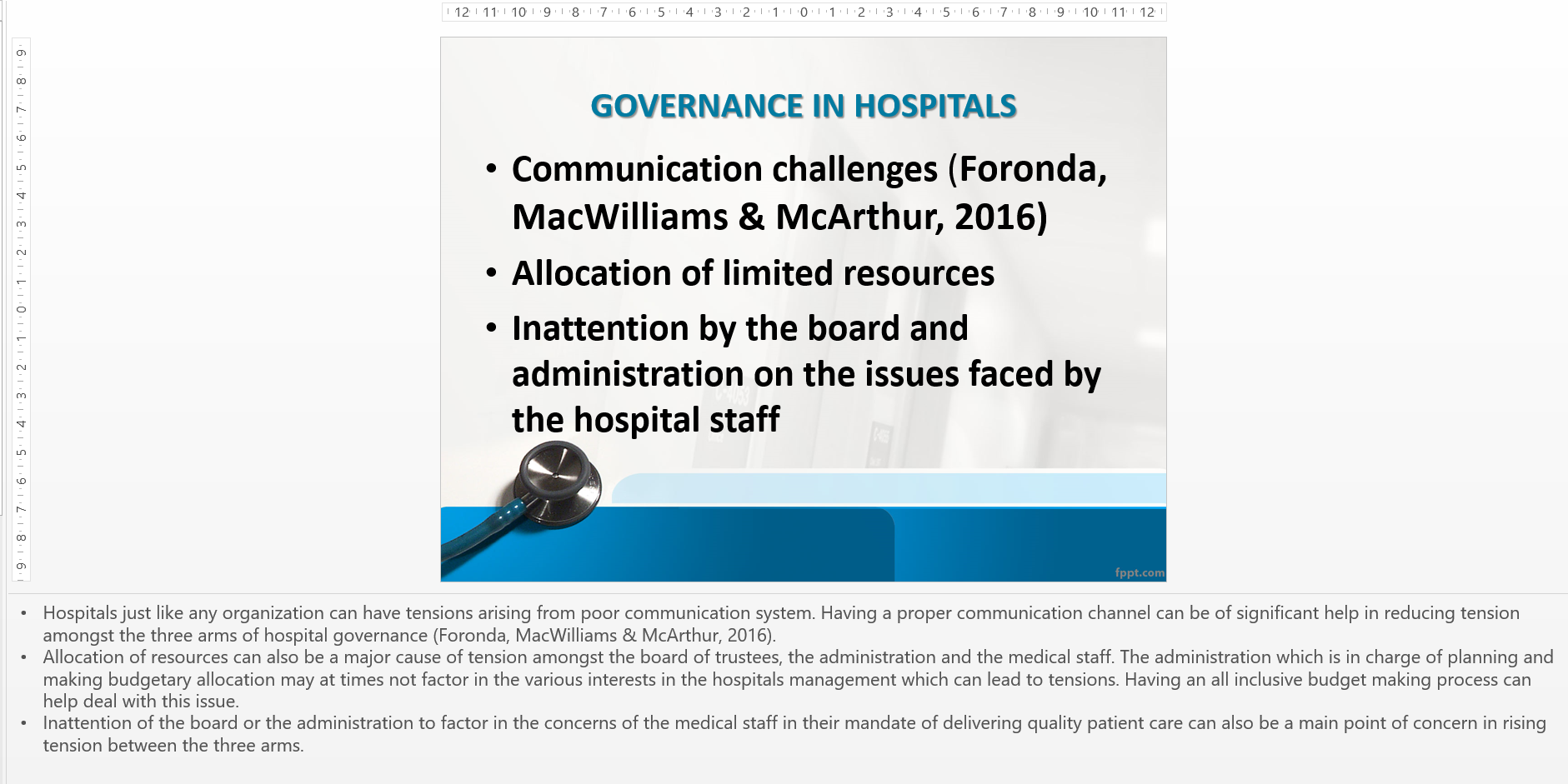
- Hospitals just like any organization can have tensions arising from poor communication system. Having a proper communication channel can be of significant help in reducing tension amongst the three arms of hospital governance (Foronda, MacWilliams & McArthur, 2016).
- Allocation of resources can also be a major cause of tension amongst the board of trustees, the administration and the medical staff. The administration which is in charge of planning and making budgetary allocation may at times not factor in the various interests in the hospitals management which can lead to tensions. Having an all inclusive budget making process can help deal with this issue.
- Inattention of the board or the administration to factor in the concerns of the medical staff in their mandate of delivering quality patient care can also be a main point of concern in rising tension between the three arms.
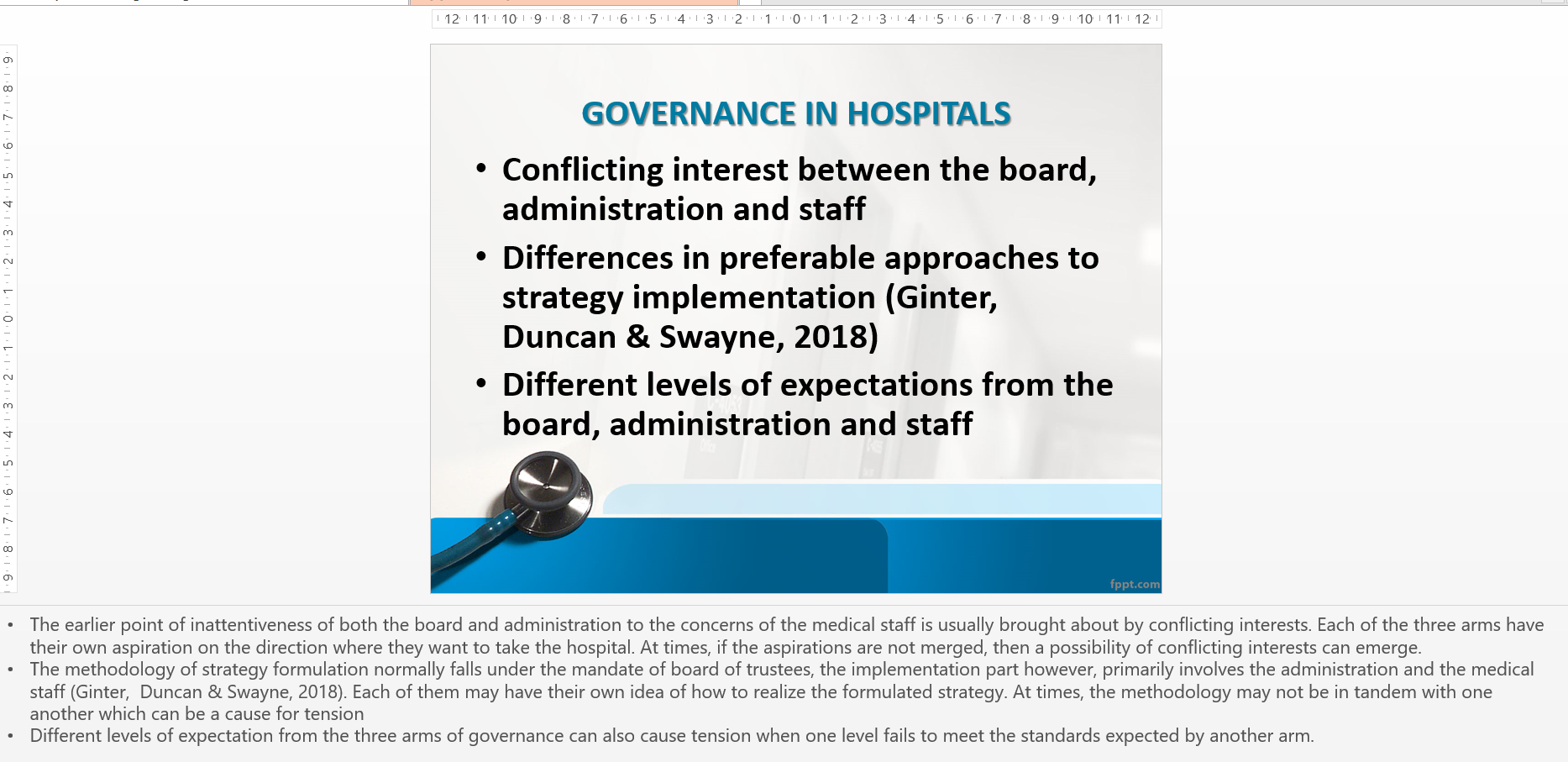
- The earlier point of inattentiveness of both the board and administration to the concerns of the medical staff is usually brought about by conflicting interests. Each of the three arms have their own aspiration on the direction where they want to take the hospital. At times, if the aspirations are not merged, then a possibility of conflicting interests can emerge.
- The methodology of strategy formulation normally falls under the mandate of board of trustees, the implementation part however, primarily involves the administration and the medical staff (Ginter, Duncan & Swayne, 2018). Each of them may have their own idea of how to realize the formulated strategy. At times, the methodology may not be in tandem with one another which can be a cause for tension
- Different levels of expectation from the three arms of governance can also cause tension when one level fails to meet the standards expected by another arm.
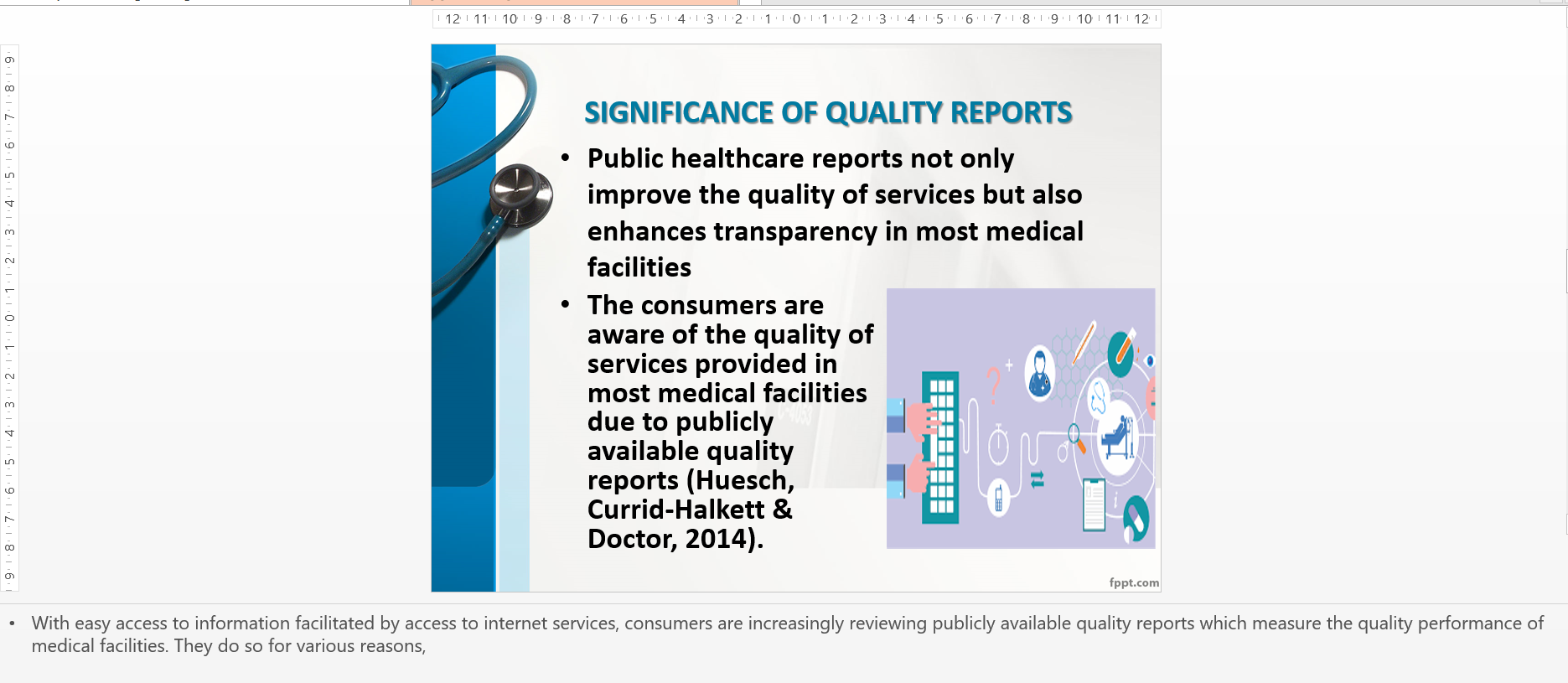
- With easy access to information facilitated by access to internet services, consumers are increasingly reviewing publicly available quality reports which measure the quality performance of medical facilities. They do so for various reasons,
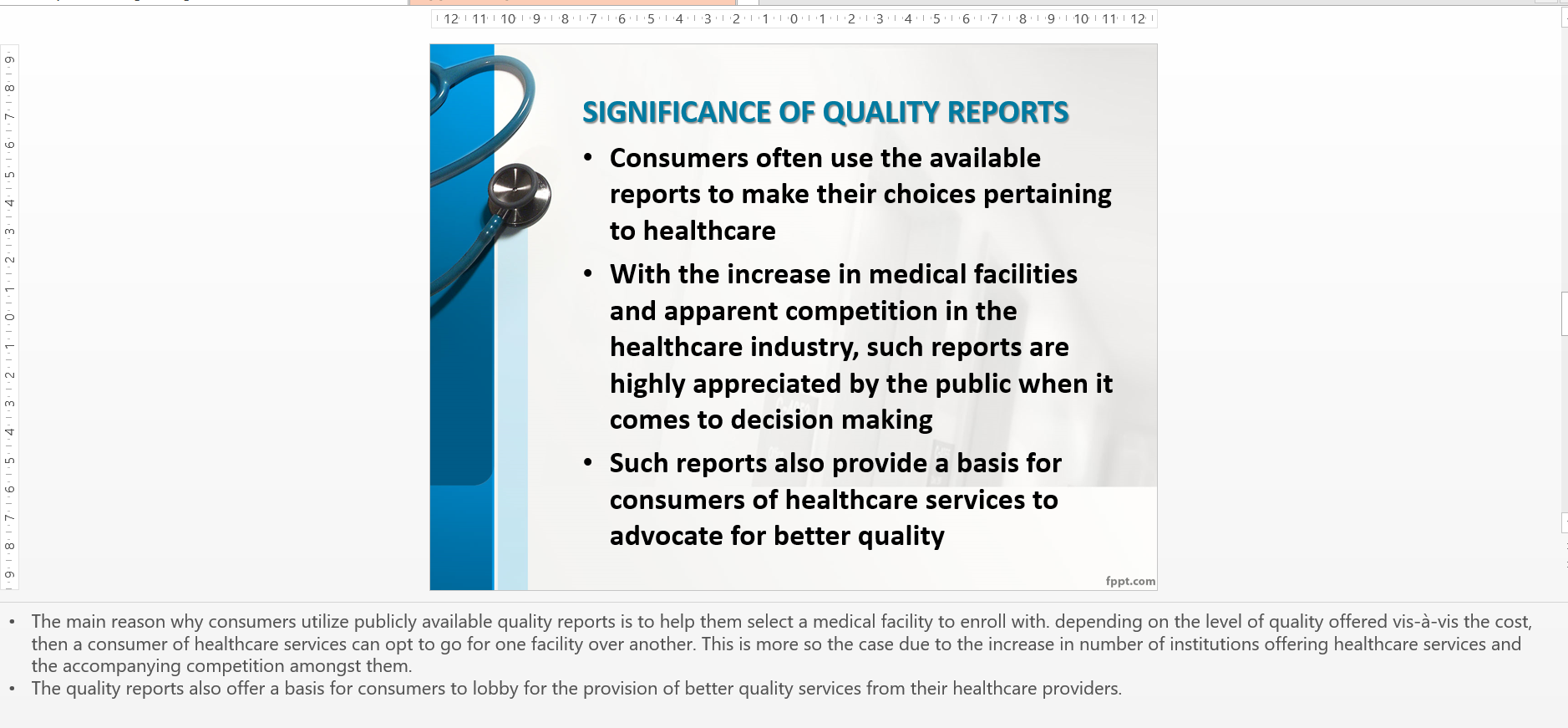
- The main reason why consumers utilize publicly available quality reports is to help them select a medical facility to enroll with. depending on the level of quality offered vis-à-vis the cost, then a consumer of healthcare services can opt to go for one facility over another. This is more so the case due to the increase in number of institutions offering healthcare services and the accompanying competition amongst them.
- The quality reports also offer a basis for consumers to lobby for the provision of better quality services from their healthcare providers.
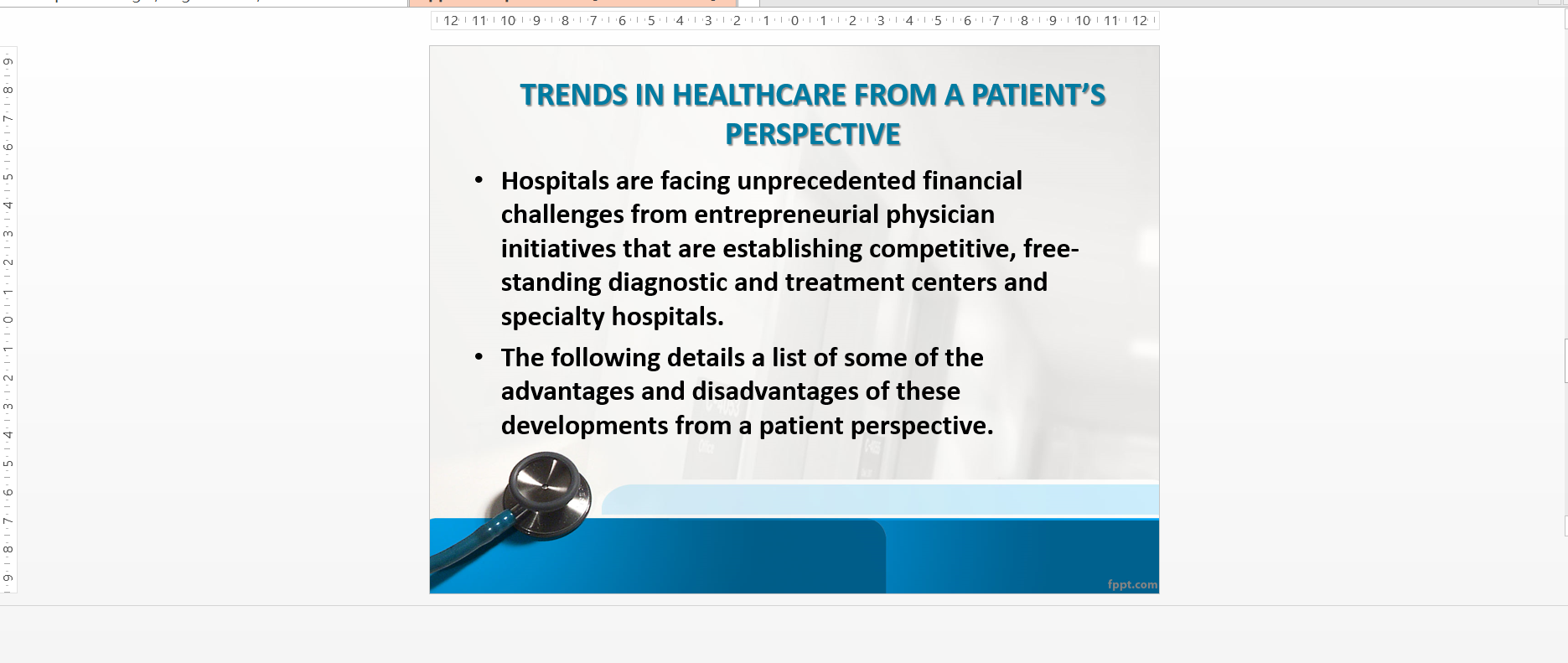
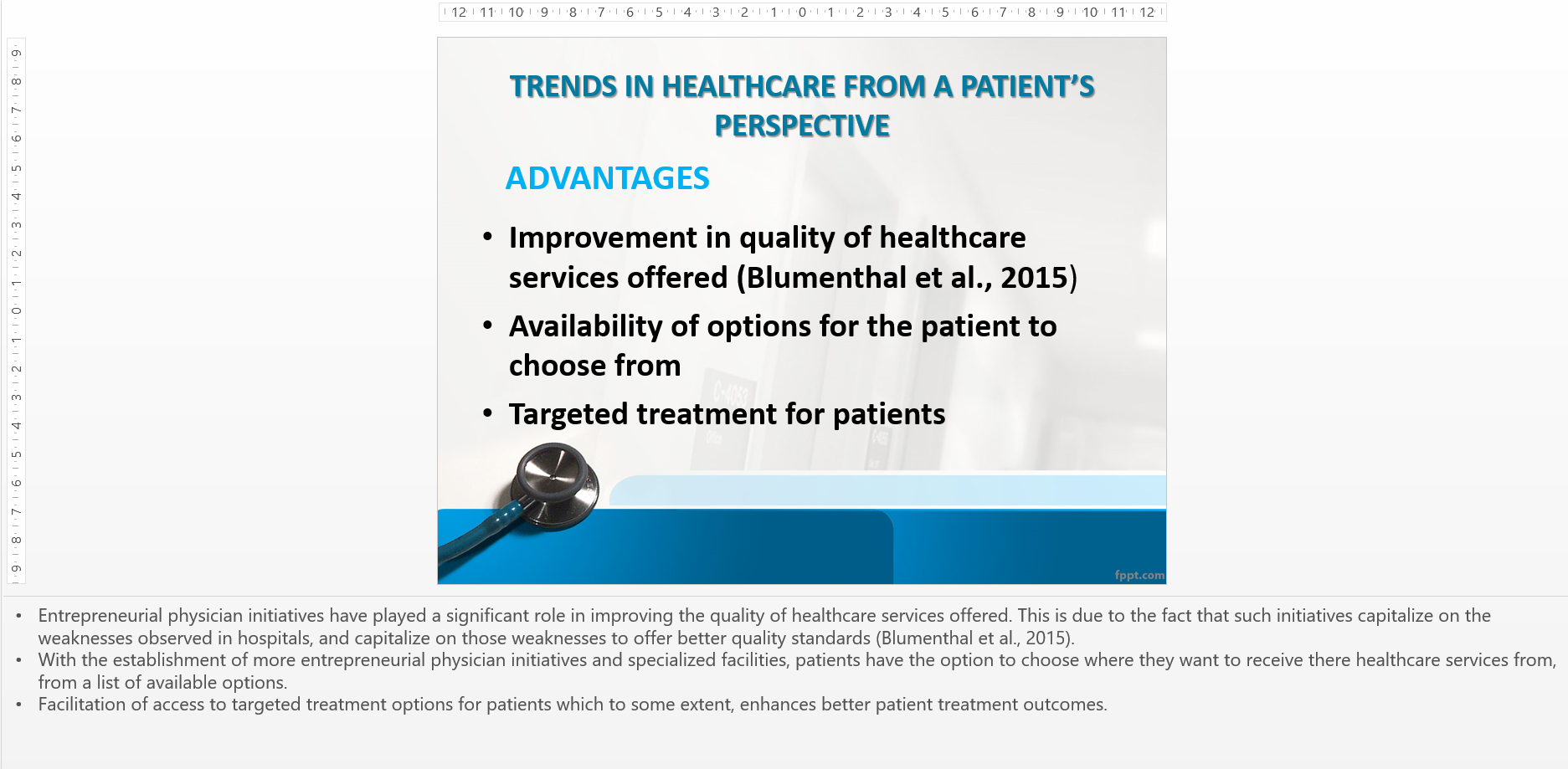
- Entrepreneurial physician initiatives have played a significant role in improving the quality of healthcare services offered. This is due to the fact that such initiatives capitalize on the weaknesses observed in hospitals, and capitalize on those weaknesses to offer better quality standards (Blumenthal et al., 2015).
- With the establishment of more entrepreneurial physician initiatives and specialized facilities, patients have the option to choose where they want to receive there healthcare services from, from a list of available options.
- Facilitation of access to targeted treatment options for patients which to some extent, enhances better patient treatment outcomes.
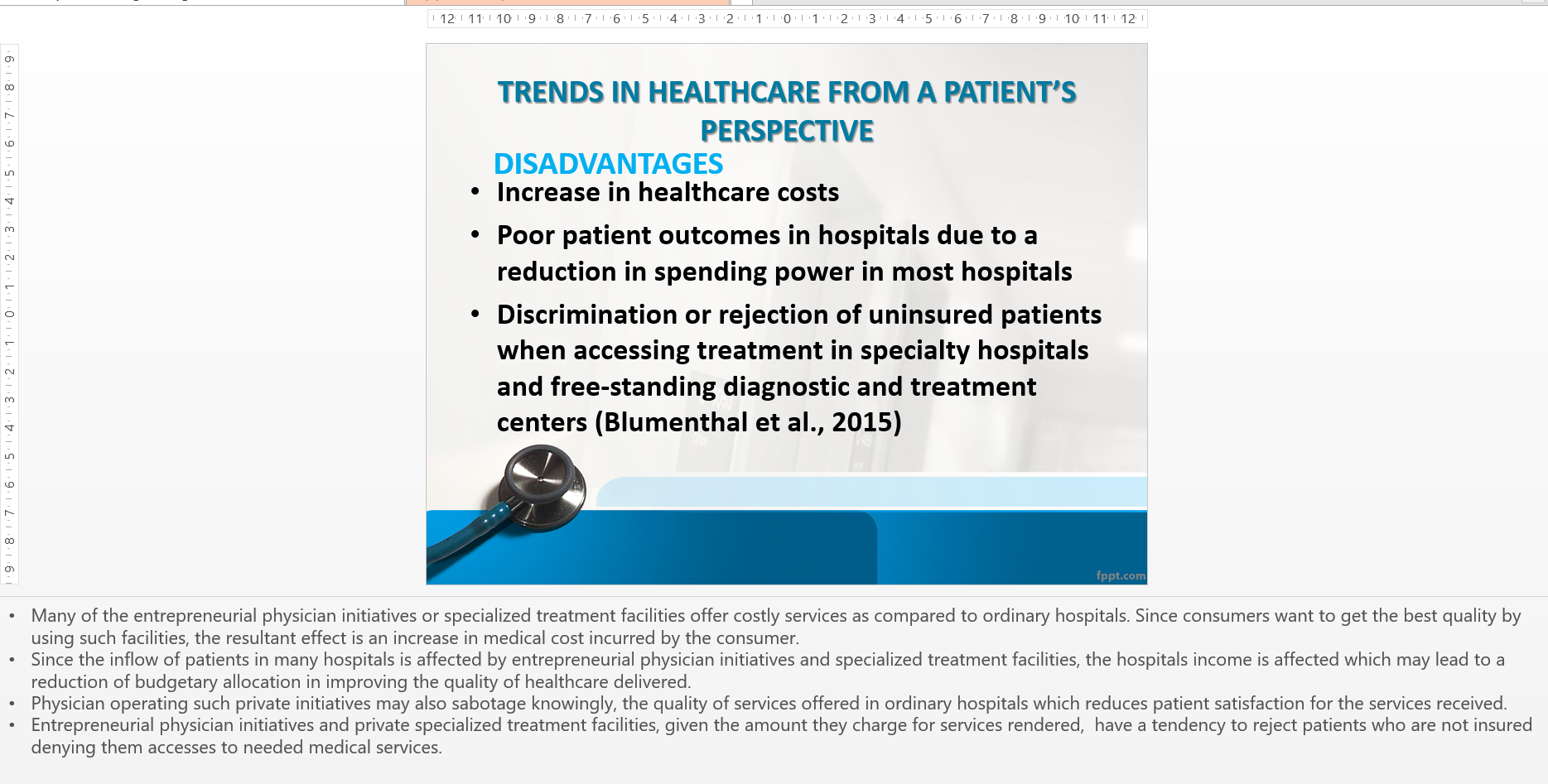
- Many of the entrepreneurial physician initiatives or specialized treatment facilities offer costly services as compared to ordinary hospitals. Since consumers want to get the best quality by using such facilities, the resultant effect is an increase in medical cost incurred by the consumer.
- Since the inflow of patients in many hospitals is affected by entrepreneurial physician initiatives and specialized treatment facilities, the hospitals income is affected which may lead to a reduction of budgetary allocation in improving the quality of healthcare delivered.
- Physician operating such private initiatives may also sabotage knowingly, the quality of services offered in ordinary hospitals which reduces patient satisfaction for the services received.
- Entrepreneurial physician initiatives and private specialized treatment facilities, given the amount they charge for services rendered, have a tendency to reject patients who are not insured denying them accesses to needed medical services.
References
Huesch, M. D., Currid-Halkett, E., & Doctor, J. N. (2014). Public hospital quality report awareness: evidence from National and Californian Internet searches and social media mentions, 2012. BMJ open, 4(3), e004417.
Blumenthal, D. M., Orav, E. J., Jena, A. B., Dudzinski, D. M., Le, S. T., & Jha, A. K. (2015). Access, quality, and costs of care at physician owned hospitals in the United States: observational study. Bmj, 351, h4466.
Foronda, C., MacWilliams, B., & McArthur, E. (2016). Interprofessional communication in healthcare: An integrative review. Nurse education in practice, 19, 36-40.
Ginter, P. M., Duncan, W. J., & Swayne, L. E. (2018). The strategic management of health care organizations. John Wiley & Sons.
Use Coupon Code: NEW30 to Get 30% OFF Your First Order
Answered Questions:
[ANSWERED] Identify a quality improvement opportunity in
[ANSWERED] Develop an interview questionnaire to be used in a family-focused functional assessment
[ANSWERED] Select a family, other than your own, and seek
ANSWERED! In this project you will select an organization or
[ANSWERED] What is the significance of the product lifecycle
ANSWERED! How can different types of attributions and
ANSWERED!! Lily is a 20-year-old student at
FAQs
What role does governance play in determining the structure of the organization
Governance plays a critical role in determining the structure of an organization. Governance refers to the set of processes, practices, and policies that guide decision-making and control within an organization.
Effective governance helps to ensure that the organization’s goals are aligned with the interests of its stakeholders, and that decisions are made in a transparent, accountable, and ethical manner. It also helps to establish clear lines of authority and responsibility, and to promote the efficient use of resources.
The structure of an organization is closely linked to its governance model. The governance model determines how decisions are made, who is responsible for making them, and how they are implemented. This, in turn, influences the organizational structure by determining the hierarchy of roles and responsibilities, the distribution of decision-making power, and the relationships between different departments and functions.
For example, in a centralized governance model, decision-making power is concentrated at the top of the organization, with little input from lower-level employees. This often results in a hierarchical organizational structure, with clear lines of authority and limited autonomy for individual departments or teams.
In contrast, a decentralized governance model may result in a flatter organizational structure, with more decision-making power distributed across the organization. This allows for greater flexibility and innovation, but may also require more coordination and communication between departments.
Overall, the governance model that an organization adopts has a significant impact on its structure, culture, and performance. Therefore, it is important for organizations to carefully consider their governance framework when designing their organizational structure.
What is the role of governance in healthcare and why is it important?
Governance plays a critical role in healthcare by providing a framework for decision-making, accountability, and transparency. The healthcare sector is highly regulated and complex, with a wide range of stakeholders, including patients, healthcare providers, payers, regulators, and policymakers. Effective governance is essential for ensuring that healthcare organizations operate efficiently, provide high-quality care, and meet the needs of their stakeholders.
Here are some specific ways in which governance is important in healthcare:
- Ensuring patient safety: Effective governance helps to ensure that patient safety is a top priority in healthcare organizations. By establishing clear policies and procedures for quality and safety, and by holding healthcare providers accountable for their performance, governance helps to reduce the risk of medical errors and adverse events.
- Promoting accountability: Governance provides a framework for accountability, both within healthcare organizations and in the broader healthcare system. By establishing clear roles and responsibilities for different stakeholders, governance helps to ensure that everyone is held accountable for their actions and decisions.
- Facilitating collaboration: Healthcare is a complex and collaborative endeavor, involving multiple stakeholders and organizations. Effective governance helps to facilitate collaboration and communication among these stakeholders, promoting better coordination and integration of care.
- Ensuring compliance with regulations: Healthcare is heavily regulated, with a wide range of laws and regulations governing everything from patient privacy to reimbursement policies. Effective governance helps to ensure that healthcare organizations comply with these regulations, reducing the risk of legal and financial penalties.
- Promoting transparency: Healthcare is a high-stakes industry, with significant consequences for patients and other stakeholders. Effective governance promotes transparency by ensuring that healthcare organizations are open and honest about their performance and decision-making processes.
3 components of governance structure of a healthcare organization
The governance structure of a healthcare organization refers to the framework of policies, practices, and processes that guide decision-making and control within the organization. Here are three key components of a governance structure for a healthcare organization:
- Board of Directors: The board of directors is responsible for overseeing the overall strategy and performance of the healthcare organization. It provides guidance and direction to senior management, approves major decisions and initiatives, and ensures that the organization is meeting its legal and ethical obligations. The board is typically composed of a mix of internal and external members, including healthcare professionals, business leaders, and community representatives.
- Executive Leadership: The executive leadership team is responsible for managing the day-to-day operations of the healthcare organization. This includes developing and implementing policies and procedures, managing financial resources, and ensuring that the organization is meeting its goals and objectives. The executive team typically includes a CEO or President, Chief Medical Officer, Chief Financial Officer, and other senior leaders with specific areas of expertise.
- Committees: Healthcare organizations typically have a range of committees that are responsible for specific functions or areas of the organization. For example, there may be a quality improvement committee that is responsible for ensuring that the organization is providing high-quality care, a finance committee that oversees financial planning and management, and a compliance committee that ensures that the organization is complying with relevant laws and regulations.
These committees are typically composed of members of the board of directors, executive leadership team, and other staff members with relevant expertise.
Board of directors responsibilities in healthcare
The Board of Directors in a healthcare organization plays a crucial role in providing oversight and guidance to ensure that the organization is fulfilling its mission and providing high-quality care to patients. Here are some of the key responsibilities of the Board of Directors in healthcare:
- Strategic Planning: The Board of Directors is responsible for setting the strategic direction of the healthcare organization, including developing long-term plans and goals. This involves working with executive leadership to identify the organization’s strengths, weaknesses, opportunities, and threats, and determining how to best position the organization to achieve its goals.
- Financial Oversight: The Board of Directors is responsible for ensuring the financial stability and sustainability of the healthcare organization. This includes overseeing the development and implementation of the organization’s budget, monitoring financial performance, and ensuring that the organization has adequate resources to meet its goals.
- Quality and Safety Oversight: The Board of Directors is responsible for ensuring that the healthcare organization provides high-quality, safe care to patients. This involves monitoring quality and safety metrics, reviewing patient feedback and complaints, and ensuring that the organization has effective systems in place to identify and address issues related to quality and safety.
- Regulatory Compliance: The Board of Directors is responsible for ensuring that the healthcare organization complies with all relevant laws and regulations. This includes overseeing the development and implementation of policies and procedures related to compliance, monitoring compliance with regulatory requirements, and ensuring that the organization has effective systems in place to identify and address compliance issues.
- Executive Leadership Oversight: The Board of Directors is responsible for overseeing the performance of the executive leadership team, including the CEO or President and other senior leaders. This includes evaluating their performance, setting compensation, and ensuring that they are fulfilling their roles and responsibilities effectively.

